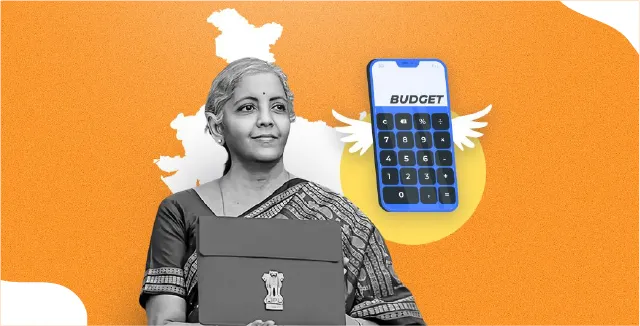
Author
LoansJagat Team
Read Time
6 Min
24 Jul 2025
What is a Budget Line? Meaning, Graph & Economic Use
A budget line is a graph that shows all the combinations of two goods a consumer can buy using their fixed income, given the prices of the goods. It represents the limit of what a consumer can afford.
For example, Ravi has ₹10 and wants to spend it on 2 goods—X and Y. Both cost ₹5 per unit. He has 3 choices: buy 2 units of X, 2 units of Y, or one unit of each. All these choices cost exactly ₹10.
Here is a simple table:
These combinations, when plotted, form a straight, downward-sloping line, known as the budget line. It shows that spending more on one good means spending less on the other. This helps consumers make the best use of their income.
Key Properties of a Budget Line
A budget line has two important properties that help us understand consumer choices. Let’s explore them in simple terms with an example and a table.
1. The Budget Line Slopes Downward
The budget line always slopes downwards from left to right. This happens because if a consumer wants to buy more of one good, they must buy less of the other, as their income is fixed.
For Example, Ravi has ₹10. Goods X and Y both cost ₹5 each. If Ravi wants to buy more of Good X, he must buy fewer units of Good Y.
As Ravi increases Good X from 0 to 2, he reduces Good Y from 2 to 0. This trade-off causes the line to slope downwards.
2. The Budget Line is a Straight Line
The budget line is always straight because the price of each good remains constant. This constant price ratio gives the budget line a steady slope.
Price Ratio = Price of Good X ÷ Price of Good Y
In Ravi’s case, both prices are ₹5, so the ratio is 1:1. That’s why the line stays straight and does not bend.
These two properties help consumers see all possible combinations they can afford and make smart decisions.
Main Features of a Budget Line
A budget line has some simple but important features. These help us understand how a person chooses between two goods while staying within their income.
1. Real Income Line
The budget line shows the actual spending ability of a person. It depends on how much money they have and what the prices of the goods are. It helps show what they can afford.
2. Straight Line
The budget line is straight because the market prices of both goods stay the same. Each point on the line represents a different combination of the two goods that utilises the full income.
3. Negative Slope
The line always slopes downwards. This is because if you buy more of one item, you must buy less of the other to stay within your budget.
Example:
A person has ₹200 and wants to buy Goods A and B. Each unit of either good costs ₹10.
As they buy more of A, they buy less of B, showing a downward slope.
4. Tangent to Indifference Curve
The budget line touches (is tangent to) the indifference curve at a single point. This point represents the consumer’s equilibrium, the optimal mix of two goods that yields the highest satisfaction within their budget.
Basic Assumptions of a Budget Line
A budget line is based on a few simple assumptions. Economists use these to make the concept clear and easy to understand. These assumptions help draw an accurate line that shows all the combinations a person can just afford.
1. Fixed Income
We assume that the consumer’s income is given and stays the same. It does not increase or decrease while choosing between the two goods.
2. Constant Prices
The prices of both goods are known and do not change. This helps create a clear line without any bends.
3. Full Knowledge of Prices
We assume that the consumer knows the price of each item. This helps them make smart and informed choices.
4. The Entire Income is Spent
The consumer is expected to spend all their income. There is no saving or wastage. Every possible point on the budget line uses the full income.
Once we know the income and prices, we can draw a straight budget line by joining all the combinations that the consumer can just afford.
Requirements for Drawing a Budget Line
To draw a budget line, certain conditions must be met. These requirements help keep the analysis simple, clear, and useful for understanding consumer choices.
Here is a table showing the main requirements:
These simple conditions make it easy to create a budget line, which shows all the combinations of two goods a person can afford using their full income.
Core Premises Behind the Budget Line
The idea of a budget line is built on a few simplified but essential assumptions. These make it easier to understand how a consumer chooses between two goods.
Here are the main premises:
Example Table:
Suppose a consumer has ₹100 and wants to buy Good A and Good B. Each unit of A costs ₹20 and each unit of B costs ₹10.
This table follows all the above premises: two goods, fixed income, known prices, and no savings.
Understanding the Budget Set
A budget set shows every combination of two goods a consumer can buy without spending more than their income. It includes all affordable options, not just those that use up all the money.
Key factors:
- Income (I) – the total amount the consumer has
. - Prices (p₁ and p₂) – how much each unit of the two goods costs.
Mathematically:
p₁ × q₁ + p₂ × q₂ ≤ I
Where q₁ and q₂ are quantities of the two goods
Example with Real Budget News
Let us say that every day, consumers decide between electric vehicles (EVs) and solar panels for their homes. We'll use figures based on recent announcements.
From Budget 2025:
- The government reduced basic customs duty on lithium-ion battery components from 10% to 5%.
- It also exempted critical minerals like cobalt powder from customs duty.
These steps have lowered the market price of EVs and solar-related goods.
The Setup
- Income (I): ₹200,000
- Price of EV (p₁): originally ₹150,000, now ₹140,000
- Price of a solar panel system (p₂): originally ₹60,000, now ₹57,000
The Budget Constraint
140,000 × q₁ + 57,000 × q₂ ≤ 200,000
Because prices fell, the budget set expands—either you can buy more of one good, more of both, or a combination previously unaffordable.
Conclusion
The budget line helps us understand how a consumer chooses between two goods using a fixed income. It shows all the combinations of the two goods that a person can buy by spending their entire income. The line slopes downwards and stays straight because prices are constant, and buying more of one good means buying less of the other.
FAQ’s
1. What is a budget line?
A budget line shows all the possible combinations of two goods a person can buy using their full income.
2. Why does the budget line slope downwards?
It slopes downwards because buying more of one good means buying less of the other.
3. Why is the budget line straight?
The line is straight because the prices of both goods stay constant.
4. What lies inside the budget line?
Combinations inside the line are affordable but do not use the full income.
5. Can the budget line shift?
Yes, it shifts if the income or the prices of goods change.
Other Informative Pages | ||
About the Author

LoansJagat Team
‘Simplify Finance for Everyone.’ This is the common goal of our team, as we try to explain any topic with relatable examples. From personal to business finance, managing EMIs to becoming debt-free, we do extensive research on each and every parameter, so you don’t have to. Scroll up and have a look at what 15+ years of experience in the BFSI sector looks like.

Quick Apply Loan
Subscribe Now
Related Blog Post


